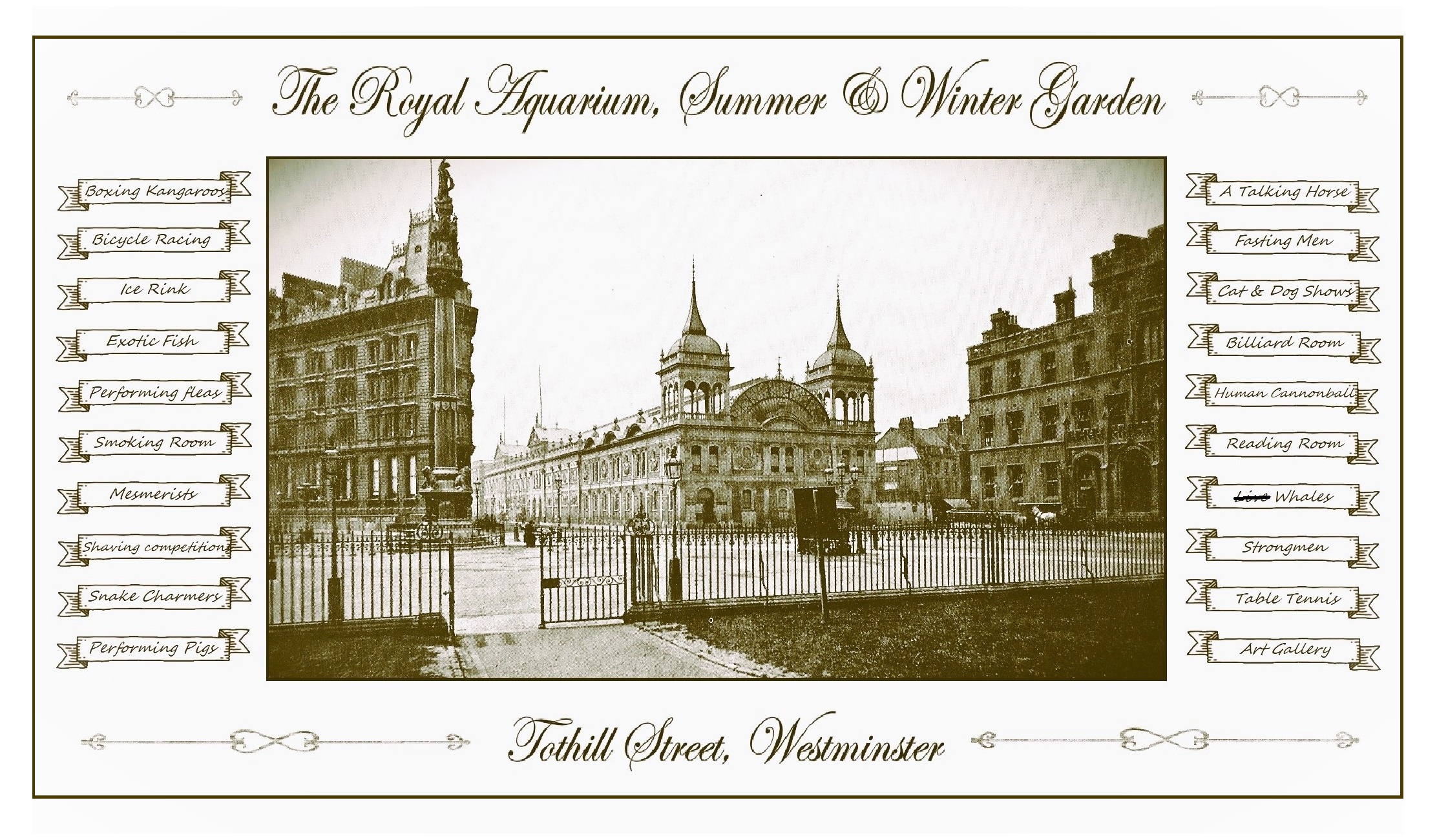
The Royal Aquarium, Summer & Winter Garden opened in 1876 just a stone’s throw from the Houses of Parliament. It was an admirable but ultimately futile attempt at the ‘moral elevation of the people by the contemplation of the wonders of nature’, which subsequently became a huge amusement palace, scraping a living for its shareholders from sensation acts more usually found in circuses.
Designed by Alfred Bedborough in a classical style and constructed of red brick and Portland stone, the striking Royal Aquarium was the brainchild of Wybrow Robertson, theatre manager, and Henry Labouchère, future MP and author of the Labouchère amendment that put paid to Oscar Wilde. The vast building, 600ft long and 160ft wide, occupied a site left vacant by the construction of the Metropolitan District Railway, and was opened with due pomp and ceremony by the Duke of Edinburgh. It incorporated an ice rink, fish tanks, restaurants and bars, a smoking room and billiard room, art gallery, fountains, and a grand hall with a huge arched glass roof reminiscent of the Crystal Palace. There was even a telegraph office, fitted with a division bell linked to Parliament as it was believed MPs would be among the building’s clientele.
Once opened, it became obvious that moral elevation does not pay the bills. The situation wasn’t helped by water-pump problems preventing the thirteen fishtanks from ever being properly operational. Someone had had the bright idea of embedding much of the water system and massive reservoirs among the foundations, making repairs almost impossible. Things deteriorated further when Arthur Sullivan, the musical director, lost interest due to small crowds and terrible accoustics. John Everett Millais organised the first art exhibition but it failed to bring in the punters and he followed Sullivan out the door.
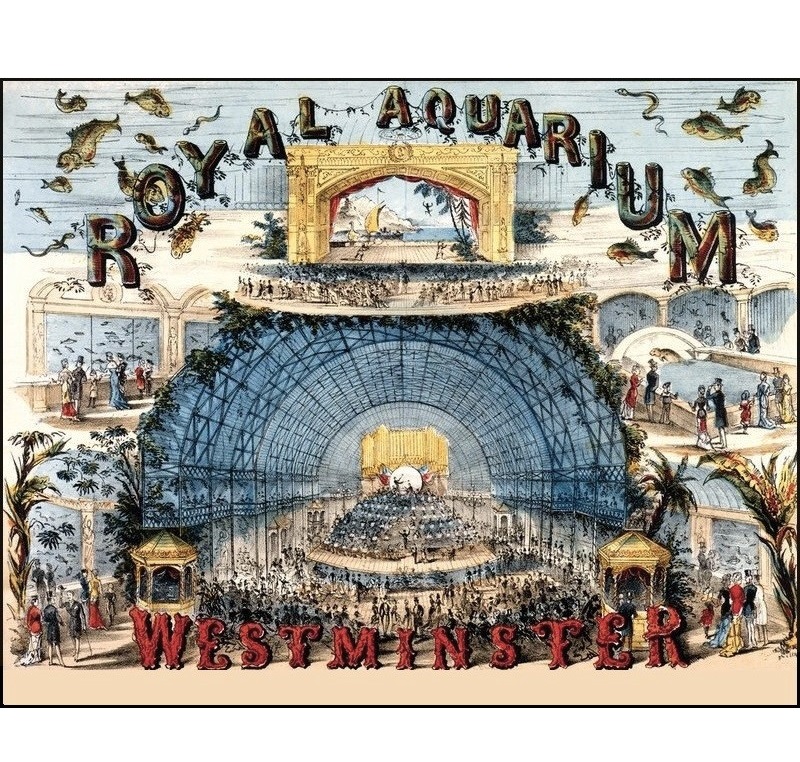
← An early advertising poster.
x
With shareholders panicking, Wybrow moved swiftly from high-brow to low-brow and, to quote John Sands, ‘in perpetual financial trouble, and with a dwindling public, the Westminster leviathan thus degenerated from a … temple of learning into a glorified freak-show’. Both investors and visitors were in for a bumpy, bizarre, and at times bewildering ride. The new approach began with the successful appearance of a French juggler, M. Trewey, and would end thirty years later with the fictional suicide of an MP in a play called Waste. Here follows just a few of the curious tales and eccentric characters from those three decades.
x
1877: The human cannon ball and the reluctant home secretary
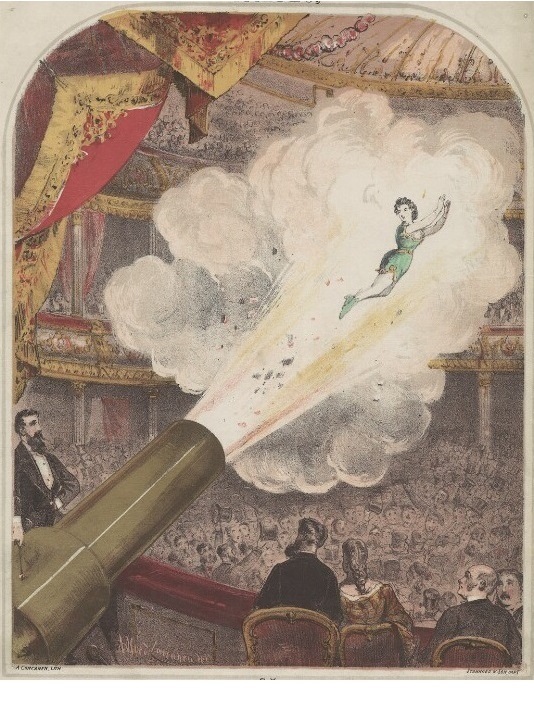
In April 1877 the famous Zazel arrived at the Royal Aquarium. This young lady, born Rossa Richter, was arguably the first human cannonball – regularly shot out of a mortar gun onto a net. This act immediately caused concern in the corridors of power. Commissioner Henderson of the Metropolitan Police threatened to report the venue to the licencing authorities, implying the act was unsafe for both Zazel and the audience. In truth this concern may have been deliberately provoked by the management for publicity. Henderson didn’t appreciate that the act was a combination of skill and illusion, the lady being catapulted out of the cannon by mechanical device rather than blown out by explosive force. The flash and bang was provided by a small and safe gunpowder charge that had nothing to do with the mechanics. It was smoke and mirrors, as these things always are.
Robertson was quick to exploit the situation. Replying with testomony that the stunt was safe from the inventor of the cannon, the Great Farini (aka Bill Hunt) and two fellows of the Royal College of Surgeons, he invited both the Commissioner and Home Secretary Richard Cross to be ‘puffed into space’ by the contraption. Newspapers speculated that neither man would have the ‘grace, elegance and finish’ of Zazel, but the correspondence seemed to stop before the world could find out. Zazel’s performance was an immense success and she stayed at the Royal Aquarium for more than a year. The Great Farini went on to become an authority on begonias and a participant in the Klondyke goldrush.
← An illustration on sheet music for the Zazel Waltz, played each time she was fired from the cannon.
In 1880 a successor to Zazel, Zæo (born Adelaide Chilver in Norwood, south London), had a slight accident during her act, which involved being catapulted from one side of the great hall to the other. This did not prevent her from performing again a few days later to prove to the public she was not seriously hurt, but the licencing magistrates had had enough, and threatened again to terminate the venue’s licence. This time the management moved quickly to assure the magistrates that ‘all performances with mechanical projecting power’ had been banned forthwith from the Royal Aquarium.
This did not prevent the Duke of Somerset later refering to Zazel’s contraption in the House of Lords. His Grace, speaking on the issue of reporters being unable to hear their Lordships in debate, suggested tongue-in-check that the House should acquire a mechanical cannon. Assistants could then fire the hapless reporters from the gallery on one side of the house over their Lordships’ heads to the other side, thus ensuring they were always close to whoever was speaking.
In 1890 Zæo returned to Westminster with a new routine. Huge advertising posters were drawn in such a way that they seemed to show her naked. Clergymen of the Central Vigilance Society for the Repression of Immorality protested, much publicity was forthcoming and the Royal Aquarium and Zæo, splitting the profits from her performances, did very well indeed.
x
1877-83: Laplanders live, whales fail
An early colleague of Zazel at the Royal Aquarium was a beluga whale, also the idea of the Great Farini. In September 1877 the young female, 9ft in length and captured in the Arctic, was placed in a vast tank big enough to allow it to swim, in the eastern annexe known as St Stephen’s Hall. The poor beast expired just ten days later, after a period of delirium during which she repeatedly head-butted the tank walls. Blame was directed at her transportation across the Atlantic, with experts suggesting she had caught a cold while on deck.
The rush replacement was, bizarrely, a group of four Laplanders, complete with tents, sledges, reindeer, dogs and an arctic fox. It seems none of the group had colds, all survived their period on display, and were as curious about the visiting crowds as the crowds were about them.
The failure of the first whale exhibition did not prevent repeated attempts over the years. Presumably the crowds attracted over the ten days, plus the hoards keen to see the inevitable post-mortem, made it a profitable exercise. The second beluga, arriving in June 1878, lasted a month. A manatee, arriving about the same time, did better, surviving nine months. The 1881 display, a bottle-nosed whale, was dead on arrival; its 1883 successor again lasted a month. A gorilla, Pongo, didn’t last long.
At least by 1882 management could finally claim, however briefly, that the fish tanks were fully stocked.
x
1877-1902: Risqué songs about risqué ladies
On more than one occasion the Royal Aquarium risked losing its licence due to the number of prostitutes said to be using the building to meet upper-class clients. It used two main arguments at different times to head off the risk: (1) The establishment had no greater problem in this regard than any of its rivals, which was probably true. (2) There were no such women; all the Royal Aquarium’s customers and staff were of a high moral character. This was over-optimistic: The undergraduates and young men-about-town who made up a large proportion of male visitors would hang around the sales stalls, staffed by single young women, making small-talk and small purchases in the reasonable expectation that the women were not paragons of virtue.
The management could have used a third line of defense, had they but known, as one lady who visited the establishment incognito was beyond reproach. The future Queen Alexandra, as Princess of Wales, is said to have visited with her children on numerous occasions, the venue being only a short walk across St James’s Park from Marlborough House, the home she shared with philandering husband Bertie.
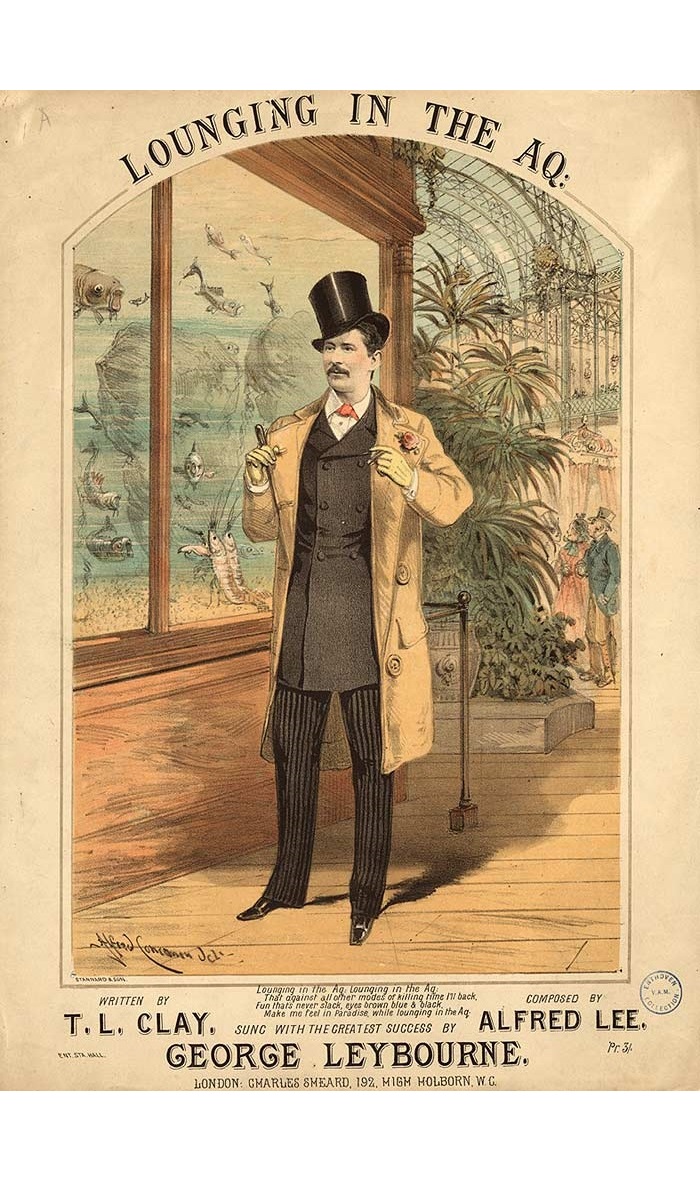
Songs made famous by music hall stars hardly aided the Royal Aquarium’s case: George Leybourne, known as Champagne Charlie after his most popular song, had a hit with ‘Lounging in the Aq’, in 1877. The song vaguely hinted at the dubious pleasures available. Rather less subtle was a dittie sung by Arthur Roberts, the music hall comic and pantomime dame. He was famous for his risqué songs and in one of them the chorus ran:
I strolled one day to Westminster
The Royal Aquarium to see;
But I had to stand a bottle just to lubricate the throttle
Of a lady who was forty-three.
George Robey, from a later generation of performers, got an early break at the Royal Aquarium when he appeared as the stooge to an American burlesque mesmerist, Professor Kennedy.
x
→ The cover illustration of Leybourne’s sheet music at least shows a positive view of the troublesome fish tanks.
x
1878: Famous actor sticks to the script to the bitter end
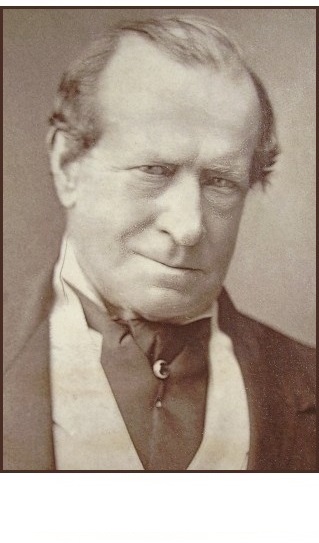
The Royal Aquarium development had included a theatre with its own entrance, initially named after its sibling. Given it had nothing to do with fish, a rapid name change to the Imperial was sensible. It had 1,300 seats and soon gained – and never lost – a reputation for being unsuccessful and unlucky. It was dark for long periods from the mid-1880s onwards, at times being used as an annexe to the aquarium for various side-shows.
An early victim of its reputation was the hugely respected, aging actor Samuel Phelps, famed for his Shakespearean productions that adhered to the bard’s original scripts, and unsurpassed in comedic roles. He continued performing into the 1870s and took to the Imperial’s stage to play Cardinal Wolsey in Shakepeare and Fletcher’s Henry VIII in March 1878. Ominously, he had previously expressed a wish that Wolsey be his valedictory role.
It was. Having started the character’s key speech ‘Farewell, a long farewell to all my greatness’ he collapsed and was carried off stage, never to appear on it again; it is said he almost died in the wings, but true to his character’s words he managed to linger on for seven months before expiring in a farmhouse near Epping, Essex.
x
1889: Samson & Cyclops suffer their comeuppance
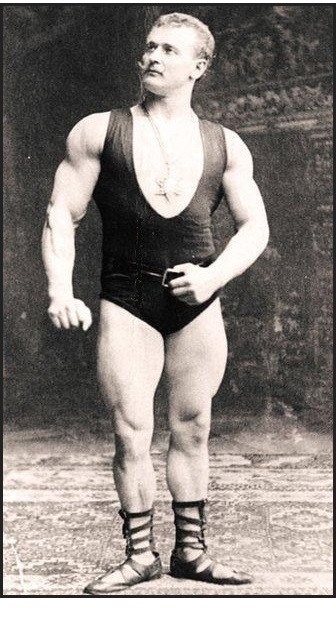
Samson and Cyclops were typical of the novelty acts at the Royal Aquarium. Although both were undoubtedly very strong, the more extreme ‘strongman’ parts of their double act revolved around clever chicanory and weights labelled as being far heavier than they really were. As part of the performance – after checking there were no rival strongmen in the audience – they offered a reward to anyone who could duplicate their lifts.
Enter one Eugen Sandow, an East Prussian strongman who had already broken every test-your-strength machine in Amsterdam on a night out. A stranger to the pair on stage, muscles hidden under dapper evening clothes, he rose from his seat one night and accepted the challenge from Cyclops, Samson’s protege, defeating him and earning a £100 reward. Samson then challenged him, promising £500 if Sandow won. The following Saturday at 10pm, with the Marquess of Queensberry looking on, a packed Imperial Theatre saw the Königsberger victorious, completing feats that an increasingly desperate Samson couldn’t match.
He went on to make a fortune working for Florenz Zeigfeld in Chicago and across America, before living out his days in London. He died aged 58 following a stroke, which many blamed on an attempt to pull his own car out of a ditch unaided.
← Sandow in one of his more modest poses. He was frequently photographed wearing only a fake fig leaf.
x
1901: Edward VII’s ex-mistress admits loathing hair in absurd places
At the Imperial many managements got their fingers burned and few actors got ovations. In a 1901 bid to make the theatre more appealing Lily Langtry – mediocre actor but celebrated beauty and former mistress of Edward VII – spent a lot of other people’s money rebuilding the auditorium to a design by famed theatre architect Frank Verity. This costly gambit produced a magnificent interior but no improvement at the box office. Langtry did at least manage to persuade the King and Queen to attend a gala performance in 1902, although quite what the deaf Alexandra thought of sitting through a performance by one of her husband’s ex-lovers without being able to hear a word her one-time rival was saying is not recorded.
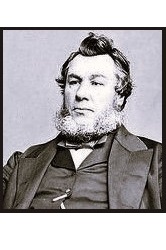
Langtry later recalled the prolonged legal disputes she had with the managing director of the Royal Aquarium, Josiah Ritchie, stating: ‘Since meeting him, I’ve vowed never to trust a man who grows hair in absurd places’, which I think is a rule of life we can all agree on. Sadly Mrs Langtry never stated what the absurd place was.
A curious piece of trivia involves Josiah’s son, christened ‘Major’. Major Ritchie never served in the military, but would go on to be the last male British tennis player to win an Olympic medal before Andy Murray. Both won gold in the singles in London, just 104 years apart. But I digress.
x
→ The absurdly-haired Josiah Ritchie
x
1902: What I like most about you is your property portfolio
By the dawn of the 20th century the aquarium building was itself a beached whale. With a morally dubious, dingy and not-very-profitable business positioned on a prime site in the heart of Westminster, the Royal Aquarium Summer and Winter Garden Society Ltd. was effectively a property company. At the annual general meetings the directors focused on the value of the site to deflect attention from the poor dividends, the long-suffering shareholders always waiting for that one juicy takeover bid that was forever just around the corner. An approach was made in 1888 by a hotel company offering £330,000 (about £30 million today) but agreement could not be reached. Tired of poor returns, in 1891 the shareholders rebelled against the existing management of Captain Molesworth. The captain, who also chaired the company that built the North Devon resort of Westwood Ho! from scratch, was replaced by Ritchie, who had made his fortune in false teeth and soon took to wearing a huge sombrero.
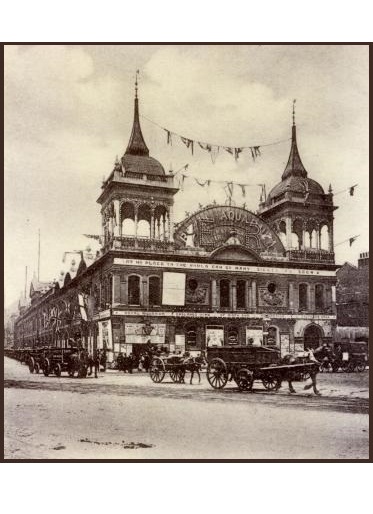
Ritchie spent his time trying to keep the business afloat while looking for a buyer. In 1896, news leaked that the Royal Aquarium had been offered to the London County Council, presumably as a site for County Hall, but ultimately a deal could not be struck. Finally, in 1902 Ritchie landed a buyer: The Wesleyans, with their ‘Million Guineas Fund’, decided it would make the perfect location for the Methodist Central Hall and offered the same amount as the hotel company had 14 years before. This time it proved irresistable to the exasperated investors. After 27 years of sensation and financial struggle, the building closed in January 1903 with a gala night; a lone crocodile surviving in one of the tanks looked on and probably shed no tears. In those 27 years, there had been not a single serious accident involving humans, but the animal kingdom had suffered grievously.
Ritchie awarded himself £3,000 of the sale price despite the protests of shareholders.
x
← The Royal Aquarium decked out with flags and bunting to celebrate the coronation of King Edward VII in the summer of 1902. It was around this time that the sale of the building was announced.
Those writers with first-hand experience of the Royal Aquarium have left us mixed messages. Ralph Nevill clearly hated it. He saw it as dreary and depressing, with zero entertainment value beyond some of the music hall acts, and even describes it as a ‘horror of London’. E. Beresford Chancellor had very different memories. He clearly loved the place and could still hear, twenty years after its demolition, the click of billiard balls and the call to Zazel asking if she was ready. He concluded: ‘What an aquarium it was!’.
x
1903: Boxing Kangaroo finally knocked down
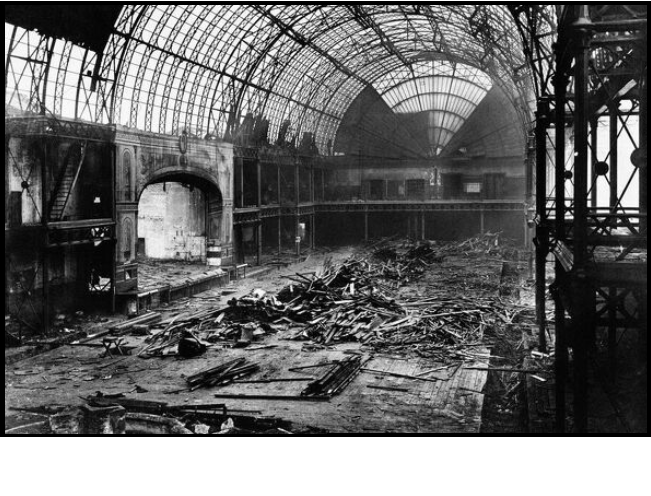
The last performance in the great hall was that of an auctioneer: A sale of contents in February lasted a week, with 1691 lots plus a separate catalogue of wines and spirits. Highlights included 154 cases of champagne and the original ‘boxing kangaroo’ – now stuffed – which newspapers humorously noted wouldn’t go for a ‘knock-down’ price. Other lots ranged from cigarettes and plaster monkeys to the huge organ, the skating rink and the 60,000 gallon iron water tank occupied so briefly by whales. Thirty large mirrors forming a maze used in Zæo’s act were bought by her husband. After the auction the site – except for the theatre – was quickly cleared.
← The Great Hall during demolition. The ‘great stage’ is on the left.
x
1903: Mum loses a fortune backing Junior’s weird ideas
The Imperial Theatre had, as well as its own entrances, its own lease. For this reason it remained standing for four years after the demolition of its neighbour. Another actor – and one with considerably more talent than Langtry – took a sublease for a season after the Jersey Lily had departed, no doubt in search of a landlord with less suspect hair.
Ellen Terry’s aim was to showcase the modern views on theatre production held by her son, Edward Gordon Craig. Unfortunately for Terry they proved too modern for a London audience; the season was a financial disaster. Her autobiography blames everyone and everything – including the height of the proscenium arch – except her son. Starting the season with the truly dour Ibsen play The Vikings was probably one miscalculation too many.
x
1907: Imperial Theatre gets wasted and migrates to Canning Town
The rebuilt interior had been widely praised and was only six years old when demolition loomed. In a canny business move and early ‘green’ development, the methodists sold it on for re-use; it was to be dismantled and rebuilt six miles to the east as the new auditorium of the Imperial Palace of Varieties in Canning Town.
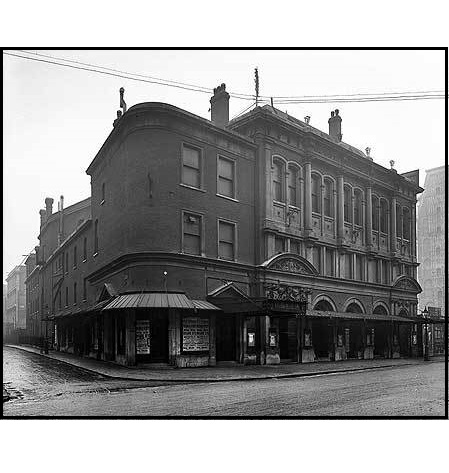
The Imperial’s greatest moment was both a first and last: The last performances staged there, on the 22nd and 24th November 1907, were the first of Harley Granville Barker’s finest and most controversial play, Waste. It was performed privately by the Stage Society as it had been refused a licence by the Lord Chamberlain. The plot was too much for the establishment: An MP commits suicide after an affair results in a botched abortion and the death of his upper-class lover, and his bill to disestablish the Church of England fails in the House of Commons. The problem was not so much abortion, but abortion among the ruling class. Waste has been revived frequently since finally receiving a licence in the 1930s. The last act on the Royal Aquarium site, this play was decidedly, and surprisingly, intellectual.
The demolition men, waiting in the wings, began their work after the second perfomance. The Imperial reopened in Canning Town in 1909, but was destroyed by fire in 1931.
← The theatre in its final days in Westminster, with dismal weather and a gap to its right where the Royal Aquarium had once stood.
x
1946: A word from the United Nations
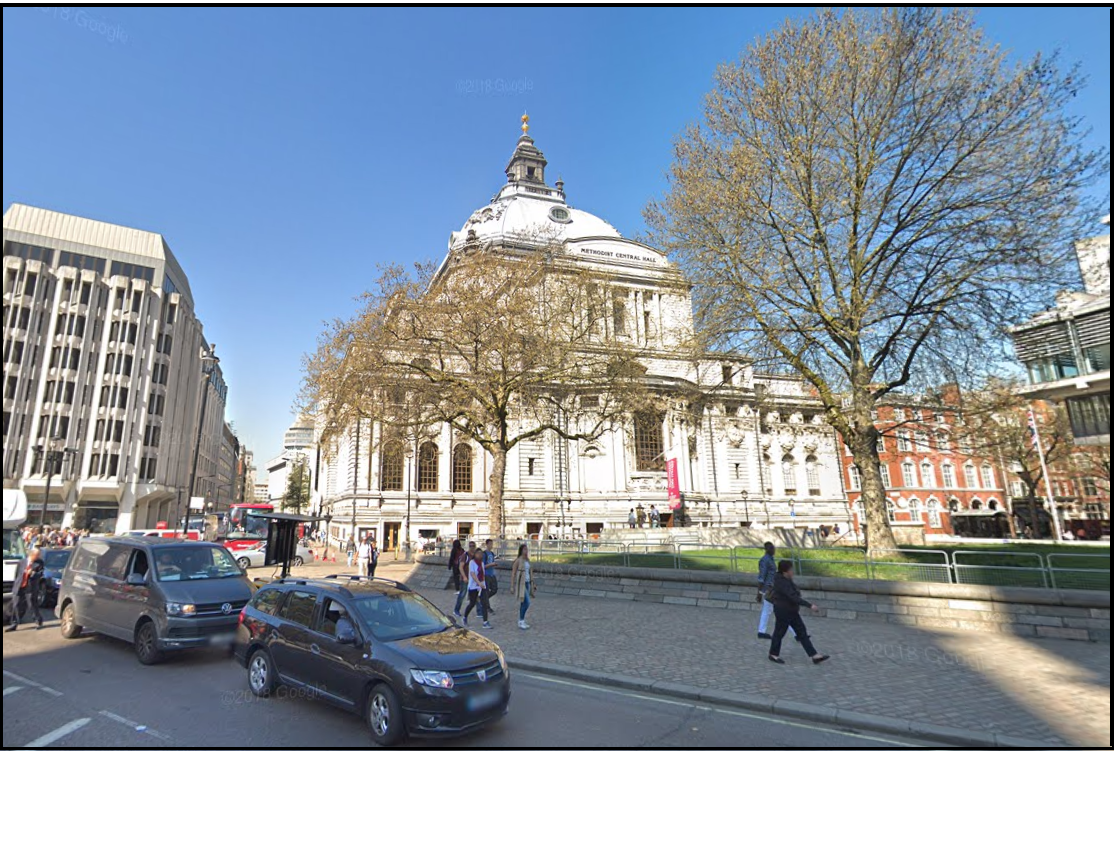
The Methodist Central Hall, an Edwardian Baroque edifice with a huge dome, was eventually completed in 1911. It takes up only a third of the vast Royal Aquarium site; a new road and offices now stand on the remainder. The Central Hall has an art gallery, café and various conference rooms, and has provided some of the sober contributions to mankind the Royal Aquarium failed to: It has seen suffragette meetings and various public inquiries, but perhaps its greatest moment came when it hosted the inaugural sessions of the General Assembly of the United Nations in 1946.
← The Central Hall in 2018
Postscript: The football world cup was displayed in the Methodist Central Hall as part of a Football Association exhibition prior to the 1966 finals. It was promptly stolen, only to be recovered a week later. The perpetrator was never caught; I can’t help wondering if it was the ghost of Josiah Ritchie or Wybrow Robertson, up to their old tricks engineering a publicity stunt to boost visitor numbers.
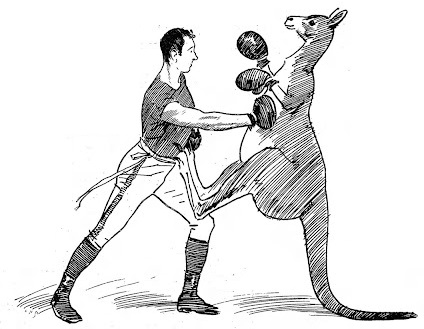
Nearest Stations: Westminster; St James’s Park
Credits:
Selected Bibliography: